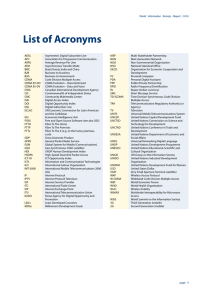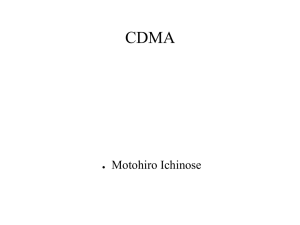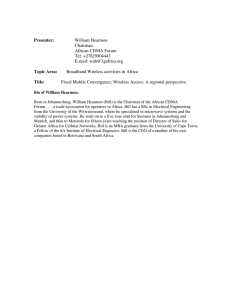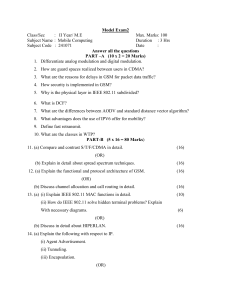IEEE C802.16j-07/444 Project Title
advertisement
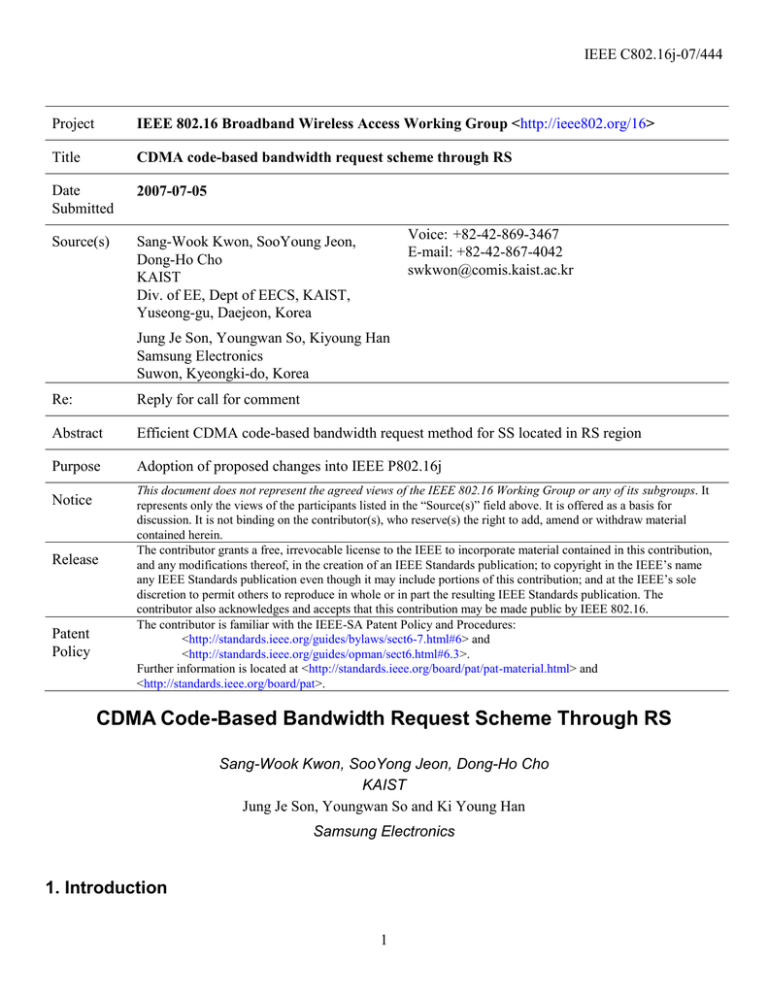
IEEE C802.16j-07/444
Project
IEEE 802.16 Broadband Wireless Access Working Group <http://ieee802.org/16>
Title
CDMA code-based bandwidth request scheme through RS
Date
Submitted
2007-07-05
Source(s)
Sang-Wook Kwon, SooYoung Jeon,
Dong-Ho Cho
KAIST
Div. of EE, Dept of EECS, KAIST,
Yuseong-gu, Daejeon, Korea
Voice: +82-42-869-3467
E-mail: +82-42-867-4042
swkwon@comis.kaist.ac.kr
Jung Je Son, Youngwan So, Kiyoung Han
Samsung Electronics
Suwon, Kyeongki-do, Korea
Re:
Reply for call for comment
Abstract
Efficient CDMA code-based bandwidth request method for SS located in RS region
Purpose
Adoption of proposed changes into IEEE P802.16j
Notice
Release
Patent
Policy
This document does not represent the agreed views of the IEEE 802.16 Working Group or any of its subgroups. It
represents only the views of the participants listed in the “Source(s)” field above. It is offered as a basis for
discussion. It is not binding on the contributor(s), who reserve(s) the right to add, amend or withdraw material
contained herein.
The contributor grants a free, irrevocable license to the IEEE to incorporate material contained in this contribution,
and any modifications thereof, in the creation of an IEEE Standards publication; to copyright in the IEEE’s name
any IEEE Standards publication even though it may include portions of this contribution; and at the IEEE’s sole
discretion to permit others to reproduce in whole or in part the resulting IEEE Standards publication. The
contributor also acknowledges and accepts that this contribution may be made public by IEEE 802.16.
The contributor is familiar with the IEEE-SA Patent Policy and Procedures:
<http://standards.ieee.org/guides/bylaws/sect6-7.html#6> and
<http://standards.ieee.org/guides/opman/sect6.html#6.3>.
Further information is located at <http://standards.ieee.org/board/pat/pat-material.html> and
<http://standards.ieee.org/board/pat>.
CDMA Code-Based Bandwidth Request Scheme Through RS
Sang-Wook Kwon, SooYong Jeon, Dong-Ho Cho
KAIST
Jung Je Son, Youngwan So and Ki Young Han
Samsung Electronics
1. Introduction
1
IEEE C802.16j-07/444
As described in the IEEE802.16j-06/026r4 baseline document, there exists CDMA code-based bandwidth
request process with centralized bandwidth allocation (6.3.6.7.2.1). When SS needs to request bandwidth, the
SS will randomly select a BW request CDMA raging code. Then, the selected code will be modulated onto
Ranging Subchannel and transmitted to RS. On receiving the code, the RS shall send the appropriate RS CDMA
ranging code toward the MR-BS indicating that one of its SSs is requesting to forward a BW request header to
the MR-BS (6.3.6.7.2.1). Upon receiving this code, the MR-BS shall respond by allocating uplink bandwidth to
the RS so that the RS can send the MR-Code-REP message to the MR-BS. The CDMA code information in the
MR_Code-REP is used by the MR-BS to generate UL-MAP for the purpose of allocating uplink bandwidth to
the SS. The process is depicted in Figure 1, and the MR_Code-REP message format is shown in Table I.
SSs
RS
MR-BS
UL-MAP
UL-MAP
BW Req Code
BW Req Code
BW request / allocation
for one SS
UL-MAP
MR_Code-REP
UL-MAP : CDMA_Allocation_IE
UL-MAP : CDMA_Allocation_IE
BW Req GMH
UL-MAP
Processing Delay
BW Req GMH
UL-MAP
Data Packet
Processing Delay
UL-MAP
Data Packet
Figure 1 BW request/allocation signaling in centralized scheduling
Table I
MR_Code-REP message format
2
IEEE C802.16j-07/444
In this process, an additional resource is needed for the RS in order to transmit the MR_Code-REP message.
Then, the MR_Code-REP message includes the CDMA code information of only one SS, not many SSs.
Therefore, if several SSs attached to the RS are requesting to forward a BW request header to MR-BS, the RS
will send each RS CDMA ranging code to MR-BS for each BW request CDMA ranging code.
Therefore, we propose an efficient CDMA code-based bandwidth request scheme with centralized bandwidth
allocation using modified MR_Code-REP message or the CQICH of relay link for the IEEE 802.16j MMR
system. In the proposed method, RS relays the information related with several BW request CDMA ranging
codes to MR-BS through modified MR_Code-REP message or the CQICH of relay link. By using this proposed
method, MR-BS can allocate the bandwidth quickly and reduce the signaling overhead. This document
describes changes for the IEEE 802.16j draft to support the proposed method.
2. Proposed Method
2.1. Operation of Proposed method
To operate CDMA code-based bandwidth request process with centralized bandwidth allocation in IEEE
802.16j MMR, there are two methods in the proposed scheme. One method is that the RS uses the modified
MR_Code-REP message which is modified from MR_Code-REP. Another method is that the RS uses the
CQICH of relay link instead of MR_Code-REP message. Then, the MR-BS can allocate the CQICH of relay
link to an RS in its cell for reporting the information related with BW request CDMA ranging code. The
allocation of CQICH for RSs is performed in relay zone.
In the proposed method, if the RS receives the BW request CDMA ranging codes from SSs, then the RS counts
the number of SS which transmits the BW request CDMA ranging code. Then, using modified MR_Code-REP
message or the CQICH of relay link, the RS reports the number of SS to MR-BS. When the MR-BS receives the
number of SS that have transmitted the CDMA code from modified MR_Code-REP message or the CQICH of
relay link, the MR-BS provides SS with bandwidth allocation for BW request header or data packet by using
CDMA_Allocation_IE (8.4.5.4.3). The detailed operation procedure is as follows.
Firstly, SSs select the BW request CDMA ranging code from code set for bandwidth request. Then, the codes
are modulated onto Ranging Subchannel and transmitted to RS. On receiving the CDMA codes, the RS stores
the CDMA code information such as Repetition Coding Indication, Ranging Code, Ranging Symbol and
Ranging Subchannel in the buffer. The stored information is thereafter used when the RS transmits the
CDMA_Allocation_IE to the SS.
After checking all BW request CDMA ranging codes, the RS counts the number of SSs which have transmitted
the CDMA code for bandwidth request, then, transmits the modified MR_Code-REP message or 6-bits payload
on the CQICH of relay link to notify MR-BS the number of SSs which have transmitted CDMA codes for
bandwidth request. When the MR_Code-REP message is used, the format of MR_Code-REP message is
modified as shown in Table II and Table III. In modified MR_Code-REP message, the information related with
CDMA code such as Repetition Coding Indication, Ranging Code, Ranging Symbol and Ranging Subchannel is
not included in the field of message. The modified MR_Code-REP message has the number of SSs which have
transmitted CDMA codes for bandwidth request. On the other hand, when CQICH of relay link is used, to
distinguish SS’s number reporting from general CQI reporting on CQICH, the MR-BS transmits the
CQICH_Enhanced_Allocation_IE (8.4.5.4.16) in which Feedback Type is set as 0b110 and CQICH Type is set
as 0b000. By using above method, the RS properly can use CQICH of relay link for the purpose of reporting the
3
IEEE C802.16j-07/444
number of SSs that have transmitted the CDMA code.
TABLE II
Modified MR_Code-REP message format
Syntax
Size
Note
Modified_MR_Code_REP_Format() {
Management Message Type = 69
MR_CODE_REP TLVs
8 bits
TBA
Variable
}
TABLE III
Modified MR_Code-REP message encoding
Name
Code information about SSs
Type
(1 byte)
Length
TBA
1
Value
The number of SSs which
transmitted the BW request
CDMA ranging codes to the
RS.
On receiving the CDMA code information through modified MR_Code-REP message or the CQICH of relay
link, which is the number of SSs that have transmitted CDMA-code for bandwidth request, MR-BS provides
uplink bandwidth allocation for the SSs by sending CDMA_Allocation_IE.
However, MR-BS does not know the information related with CDMA code such as Repetition Coding
Indication, Ranging Code, Ranging Symbol and Ranging subchannel because MR-BS receives only the number
of SSs who have transmitted CDMA code through modified MR_Code-REP message or the CQICH of relay
link, not the entire CDMA codes of SSs. Therefore, when MR-BS transmits CDMA_Allocation_IE to RS, the
CDMA_Allocation_IE does not contain the fields of Repetition Coding Indication, Ranging Code, Ranging
Symbol and Ranging Subchannel. On receiving the CDMA_Allocation_IE from MR-BS, the RS inserts the
fields of Repetition Coding Indication, Ranging Code, Ranging Symbol and Ranging subchannel using the
stored information in the buffer. Then, RS transmits the CDMA_Allocation_IE for each SS. The CDMA codebased bandwidth request process with centralized bandwidth allocation is shown in Fig. 2.
In case of the MR_Code-REP method, the RS will send the MR_Code-REP to MR-BS for each BW request
CDMA ranging code, but in case of two proposed methods, the procedure of bandwidth request is done only one
time though many SSs request bandwidth.
4
IEEE C802.16j-07/444
SS
RS
MR-BS
UL-MAP
UL-MAP
BW Req Code
BW Req Code
SS 1
UL-MAP : CDMA_Allocation_IE
MR_Code-REP
UL-MAP : CDMA_Allocation_IE
UL-MAP : CDMA_Allocation_IE
UL-MAP
UL-MAP
BW Req Code
BW Req Code
SS 2
UL-MAP : CDMA_Allocation_IE
MR_Code-REP
UL-MAP : CDMA_Allocation_IE
UL-MAP : CDMA_Allocation_IE
Figure 2 Bandwidth allocation procedure using MR_Code-REP message
SS
RS
MR-BS
UL-MAP
UL-MAP
BW Req Code
RS CDMA RNG Code
UL-MAP : CDMA_Allocation_IE
SS
1, 2
Modified MR_Code-REP
UL-MAP : CDMA_Allocation_IE
UL-MAP : CDMA_Allocation_IE
Figure 3 Bandwidth allocation procedure using modified MR_Code-REP message
Figure 4 shows the operation of proposed modified MR_Code-REP message based scheme when SSs transmit
BW request CDMA ranging codes. In this figure, the number of SSs who have transmitted CDMA code is 4. So,
an RS transmits an RS CDMA ranging code to MR-BS. Upon receiving this code, the MR-BS shall respond by
allocating uplink bandwidth to the RS so that the RS can send the modified MR_Code-REP message to the MRBS. After receiving some uplink resource, the RS sends the modified MR_Code-REP message. Then, the MRBS allocates the uplink bandwidth to SS through the UL-MAP.
5
IEEE C802.16j-07/444
4
5
BS
1
de
co 1 )
A
M 10
CD 011
(10 ode
c
)
MA 0 1 0
CD 100
(11
Modified
MR_Code-REP
UL-MAP
RS
6
Ranging subchannel
MS1
2
RS CDMA
ranging code
Ranging
subchannel
3
UL-MAP
MS2
de
A co
CDM 0110)
1
(0 0 0
CDMA code
(11100010) MS3
UL-MAP
MS4
UL relay link
UL access link
Figure 4 Operation procedure of proposed modified MR_Code-REP message based scheme for SSs transmitting
BW request CDMA ranging codes
Figure 5 shows the operation of proposed CQICH based scheme when SSs transmit BW request CDMA ranging
codes. In this figure, the number of SSs who have transmitted CDMA code is 4. So, RS transmits 6-bits
payload, ‘000100’, to MR-BS through the CQICH of relay link. Then, the MR-BS allocates the uplink
bandwidth to SS through the UL-MAP.
6
IEEE C802.16j-07/444
MS1
de
co 1 )
A
M 10
CD 011
(10 ode
c
)
MA 0 0 1 0
D
C 10
(11
1
000100
2
Reporting the
number of SS
which transmitted
CDMA code
4
RS
BS
Ranging subchannel
CQICH region
MS2
de
A co
CDM 0110)
1
(0 0 0
CDMA code
(11100010) MS3
UL_MAP
3
UL_MAP
MS4
UL relay link
UL access link
Figure 5 Operation procedure of proposed CQICH based scheme for SSs transmitting BW request CDMA
ranging codes
3. Proposed Text Changes
Add a new table in 11.23.
11.23 MR Code Report management message encodings
[Change the table in section 11.23]
Name
Code information of SSs
Type
(1 byte)
Length
TBA
1
Value
The number of SSs which
transmitted the BW request
CDMA ranging codes to the
RS.
Change 6.3.6.7.2.1 as following :
6.3.6.7.2.1 Contention-based CDMA Bandwidth Requests for Relay
The MR-BS shall assign unique RS CDMA ranging codes to each RS in its MR-cell in order to reduce the
overhead and latency of various ranging processes in relay networks with centralized control (see subclause
7
IEEE C802.16j-07/444
6.3.10.3.5x). RS CDMA ranging codes are assigned to an RS during its initial ranging process by sending an
RS_CDMA_Codes TLV in the RNG-RSP.
A set of these RS CDMA ranging codes may be reserved for the purpose of informing the MR-BS that an SS
attached to the originating RS is requesting to forward a BW request header to the MR-BS. When the MR-BS
receives such a code, it shall create BW allocations on the access link and the relay links along the path to the
MR-BS for the purpose of forwarding a BW request header from the SS to the MR-BS. This requires that the
MR-BS not only know the path from the RS but also the processing time at each RS in the MR-cell.
When the RS receives BW request CDMA ranging codes from SSs, the RS stores the CDMA code information
such as Repetition Coding Indication, Ranging Code, Ranging Symbol and Ranging Subchannel in the buffer.
This stored CDMA code information is thereafter used when the RS transmits CDMA_Allocation_IE to the
SSs. Then, the RS counts the number of SSs which have transmitted CDMA code, and it shall send an
appropriate RS CDMA ranging code toward the MR-BS indicating that one of its SSs is requesting to forward a
BW request header to the MR-BS. Upon receiving this code, the MR-BS shall respond by allocating uplink
bandwidth to the RS so that the RS can send the MR-Code-REP message to the MR-BS. The Code information
of SSs in the MR_Code-REP message is used by the MR-BS to generate UL-MAP allocating uplink bandwidth
to the MS.
When the MR-BS receives the number of SSs which have transmitted CDMA codes through the MR_CodeREP message, the MR-BS transmits CDMA_Allocation_IE to the RS for providing uplink allocation for the
SSs. However, the CDMA_Allocation_IE sent from the MR-BS to the RS does not contain the fields of
Repetition Coding Indication, Ranging Code, Ranging Symbol and Ranging subchannel. Those fields are
recovered by the RS using the stored CDMA code information. Then, the recovered CDMA_Allcation_IE is
transmitted by the RS to the SSs. See figure <XXX>
SSs
RS
MR-BS
UL-MAP
UL-MAP
BW Req Code
BW Req Code
BW request / allocation
for k SSs
UL-MAP
MR_Code-REP
UL-MAP : CDMA_Allocation_IE
UL-MAP : CDMA_Allocation_IE
BW Req GMH
UL-MAP
Processing Delay
BW Req GMH
UL-MAP
Data Packet
Processing Delay
UL-MAP
Data Packet
Figure XXX CDMA based bandwidth request/allocation based on modified MR_Code-REP.
8
IEEE C802.16j-07/444
Thus, when an RS receives a BW request CDMA ranging code from one of its SSs, it shall send the appropriate
RS CDMA ranging code toward the MR-BS indicating that one of its SSs is requesting to forward a BW request
header to the MR-BS. Each intermediate RS along the path to the MR-BS relays this code in the uplink
direction. Upon receiving this code, the MR-BS shall respond by allocating uplink bandwidth to the RS along
the relay path so that the RS can send the MR-Code-REP message to the MR-BS. CDMA code information in
the MR_Code-REP is used by the MR-BS to generate UL-MAP allocating uplink bandwidth to the MS. See
figure <XXX>.
[Change the table in section 8.4.5.4.16] – CQICH Enhanced allocation IE
Syntax
CQICH_Enhanced_Alloc_IE() {
Extended-2 UIUC
CQICH_ID
Period (=p)
Frame offset
Duration (=d)
CQICH_Num
Size
(bits)
Notes
4
8
CQICH Enhance Alloc IE()=0x00
Length in bytes of following fields
Index to uniquely identify the CQICH
variable
resource assigned to the SS
A CQI feedback is transmitted on the
3
CQICH every 2p frames
The SS starts reporting at the frame of
which the number has the same 3 LSB as
3
the specified frame offset. If the current
frame is specified, the SS should start
reporting in 8 frames
3
A CQI feedback is transmitted on the CQI
channels indexed by the CQICH_ID for
10×2d frames. If d==0b000, the CQICH is
deallocated. If d == 0b111, the SS should
report until the MR-BS command for the
SS to stop.
Number of CQICHs assigned to this
4
CQICH_ID is (CQICH_Num +1)
for (i=0;i<CQICH_Num+1;i++) {
9
IEEE C802.16j-07/444
Feedback Type
0b000 - 0b010 = Fast DL
measurement/Default Feedback depending
on CQICH types
0b011 = Quantized precoding weight
feedback
0b100 = Index to precoding matrix in
codebook
0b101 = Channel Matrix Information
3
0b110-0b111 = Reserved
Allocation index
6
CQICH Type
3
0b110 = CDMA code Information for SSs
0b111 = Reserved
Index to the Fast-feedback channel region
marked by UIUC=0
0b000 = 6-bit CQI,
0b001 = reserved,
0b010 = 3-bit CQI (even)
0b011 = 3-bit CQI(odd)
0b100 = 6 bit CQI (primary)
0b101 = 4 bit CQI (secondary)
0b110-0b111 = Reserved
1
When CQICH type=000, 0 = reserved 1 =
use STTD in PUSC only (see Figure 249)
Band_AMC_Precoding_Mode
1
0 = One common precoder for all bands.
1 = Distinct precoders for the bands with
the highest S/N values, up to the number of
short term precoders fed back as specified
by Nr_Precoders_feedback
If (Band_AMC_Precoding_Mode
=1) { Nr_Precoders_feedback (=N)
}
3
Nr of precoders feedback = N
Padding
variable
The padding bits are used to ensure the IE
size is integer number of bytes.
STTD indication
}
}
Feedback Type
For CQICH type=0b000, 0b001 or 0b100:
0b000 = Fast DL measurement/Default Feedback with antenna grouping
0b001 = Fast DL measurement/Default Feedback with antenna selection
0b010 = Fast DL measurement/Default Feedback with reduced code book
When the SS transmits the feedback of S/N using 5 LSBs of 6 bits on it assigned CQICH, the MSB is set to 0
(see8.4.5.4.10.5). SS may transmit, on its assigned CQICH, the feedback information specified in 8.4.5.4.10.7
For CQICH type= 0b010 or 0b011:
0b000 = Antenna grouping (see Table 298d of 8.4.5.4.10.7)
0b001 = Antenna selection (see Table 298e of 8.4.5.4.10.7)
0b010 = Reduced codebook (see Table 298f of 8.4.5.4.10.7)
10
IEEE C802.16j-07/444
For CQICH type= 0b101:
0b000 = Fast DL measurement (see 8.4.5.4.10.1 and 8.4.5.4.10.5)
0b001 = Default Feedback with antenna grouping (see Table 298 of 8.4.5.4.10.3)
0b010 = Antenna selection and reduced codebook (see Table 298a of 8.4.5.4.10.3)
0b011 = Quantized precoding weight feedback (see Figure 231 of 8.4.5.4.10.2)
For CQICH type = 0b000:
0b110: CDMA code information for SSs
In section 8.4.5.4.3, add a comment as shown below:
Table 290 defines the UL-MAP_IE for allocation of bandwidth to a user that requests bandwidth using a CDMA
request code. This IE is identified by UIUC=14. The CDMA_allocation_IE, which is generated owing to RS’s
bandwidth request through CQICH, does not contain Repetition Coding Indication, Ranging Code, Ranging
Symbol, and Ranging subchannel field.
Add a new section 8.4.5.4.10.16
8.4.5.4.10.16 Supporting of CDMA bandwidth request
When Feedback Type is 0b110 and CQICH Type is 0b000 in the CQICH_Enhanced_Alloc_IE, the encoding of
payload describes the number of SSs who have transmitted CDMA codes for bandwidth request.
Change 6.3.6.7.2.1 as following :
6.3.6.7.2.1 Contention-based CDMA Bandwidth Requests for Relay
The MR-BS shall assign unique RS CDMA ranging codes to each RS in its MR-cell in order to reduce the
overhead and latency of various ranging processes in relay networks with centralized control (see subclause
6.3.10.3.5x). RS CDMA ranging codes are assigned to an RS during its initial ranging process by sending an
RS_CDMA_Codes TLV in the RNG-RSP.
A set of these RS CDMA ranging codes may be reserved for the purpose of informing the MR-BS that an SS
attached to the originating RS is requesting to forward a BW request header to the MR-BS. When the MR-S
receives such a code, it shall create BW allocations on the access link and the relay links along the path to the
MR-BS for the purpose of forwarding a BW request header from the SS to the MR-BS. This requires that the
MR-BS not only know the path from the RS but also the processing time at each RS in the MR-cell.
The MR-BS can allocate the CQICH of relay link to an RS in its cell for reporting the information related with
BW request CDMA ranging codes. The allocation of the CQICH for RSs is performed in relay zone.
11
IEEE C802.16j-07/444
When the RS receives BW request CDMA ranging codes from SSs, the RS stores the CDMA code information
such as Repetition Coding Indication, Ranging Code, Ranging Symbol and Ranging Subchannel in the buffer.
This stored CDMA code information is thereafter used when the RS transmits CDMA_Allocation_IE to the
SSs. Then, the RS counts the number of SSs which have transmitted CDMA code, and transmits 6-bit payload
on the CQICH (8.4.5.4.10.16) of relay link to inform the MR-BS of the number of received CDMA codes.
When the MR-BS receives the number of SSs which have transmitted CDMA codes, MR-BS transmits
CDMA_Allocation_IE to the RS for providing uplink allocation for the SSs. However, the
CDMA_Allocation_IE sent from MR-BS to RS does not contain the fields of Repetition Coding Indication,
Ranging Code, Ranging Symbol and Ranging subchannel. Those fields are recovered by the RS using the stored
CDMA code information. The recovered CDMA_Allcation_IE is transmitted by the RS to the SSs. See figure
<XXX>
SSs
RS
MR-BS
UL-MAP
UL-MAP
BW Req Code
The number of SSs which
transmitted the CDMA code
CQICH
UL-MAP : CDMA_Allocation_IE
UL-MAP : CDMA_Allocation_IE
BW Req GMH
UL-MAP
Processing Delay
BW Req GMH
UL-MAP
Data Packet
UL-MAP
Processing Delay
Data Packet
Figure XXX CDMA based bandwidth request /allocation signaling through the CQICH of relay link
Thus, when an RS receives a BW request CDMA ranging code from one of its SSs, it shall send the appropriate
RS CDMA ranging code toward the MR-BS indicating that one of its SSs is requesting to forward a BW request
header to the MR-BS. Each intermediate RS along the path to the MR-BS relays this code in the uplink
direction. Upon receiving this code, the MR-BS shall respond by allocating uplink bandwidth to the RS along
the relay path so that the RS can send the MR-Code-REP message to the MR-BS. CDMA code information in
the MR_Code-REP is used by the MR-BS to generate UL-MAP allocating uplink bandwidth to the MS. See
figure <XXX>.
12
